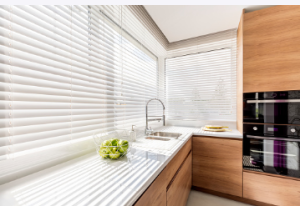Choosing the right window blinds for your home can take time and effort. There are many different types of blinds, each with different features, and each blind uses a different control system.
 Bonded roller blinds vs blackout roller blinds
Bonded roller blinds vs blackout roller blinds
Whether you’re looking to purchase bonded or blackout roller blinds for your home, it’s important to understand their differences. These two types of blinds are extremely different in their functions and benefits. Therefore, you’ll want to get the advice of an expert to ensure that you’re purchasing the right blind for your home.
The main difference between the two is the fabric used in the construction. Blockout roller blinds are made from a fabric that completely blocks out light, while bonded blinds use a fabric that is attached to the surface. It gives them a decorative finish that is perfect for any decor.
You can find bettablinds.com.au/projects/roller-blinds-adelaide/ blackout roller blinds in various colours and finishes, and they are ideal for bedrooms and lounge rooms. You can even find them in bold patterns for a contemporary look. They are a good alternative to drapes, which can be tricky to maintain.
Roller blinds are very simple to use. They’re easy to clean with warm water and a damp cloth. You can also use a vacuum attachment to remove dust and debris. You can also adjust them using a chain system or spring-loaded mechanisms. You can also use a dual bracket system to let two blinds work independently on one window.
Both types of blinds are designed to block out light and offer privacy. They come in various fabrics, such as sheer, translucent and textured. Of course, you’ll want to choose a water-resistant fabric to avoid moisture issues.
You can also choose a fabric that will filter light into the room. These are ideal for bedrooms and office spaces where you don’t want to be disturbed by sunlight. They also come in a wide variety of fabrics, so you can find a style that suits your decor. You can even opt for a double Roller Blind, which allows you to use any roller.
You can also find a wide range of bettablinds.com.au/projects/roller-blinds-adelaide/ blackout roller blinds in patterned designs. These are ideal for bedrooms or home theatres. They also have thermal properties on the back, which adds more insulation.
Fabric stiffener for roller blinds
Using fabric stiffener is a great way to prevent creases and keep your roller blinds looking neat. Fabric stiffener is available as a spray or as a solution. It is also non-toxic and easy to use. It’s also an easy way to add strength to fabrics.
Fabric stiffener is great for arts and crafts. It adds strength to fabrics while preventing creases and fraying. It’s a common tool in arts and crafts; you can also use it to make clothing.
A stiffening solution can be applied to most absorbent fabrics, but it’s important to test it on an off-cut before cutting into your fabric. You can also use it to create your roller blinds. Finally, if you’re looking for the easiest way, you can use a hair dryer or warm, sudsy water.
It’s also possible to spray paint your fabric. You can find spray paint in many colours, including red and green, perfect for soft furnishing fabrics. Spraying the fabric will cover about four square meters. Depending on the fabric and the size of your window, you may need a wider fabric.
You may also find a fabric stiffener at a home improvement store. These are usually easy to use and come in a variety of sizes. This fabric is often waterproof, but it should be vented away from the rest of the house.
The best fabric stiffener to use is Hi-Tack fabric stiffener, which is non-toxic and safe. It can be found in a bottle of 250ml. You can use this solution to make your roller blinds, and it also works with most cotton and polyester fabrics.
It’s also possible to use hairspray in place of fabric stiffener. It’s also inexpensive and can be used on any fabric. It may not be as shiny as the spray-on variety, but it will spread evenly and give you the same hardening effect.
For the best results, ensure the fabric you use is the right size for the job. Using a set square to measure your corners is a good idea. You may also need to adjust the drop of your blinds. It includes an allowance for the hem.
Child safety device
Keeping children safe around window blinds is vital. The cords in these products can be extremely hazardous to young children. There have been many incidents of strangulation and deaths related to window blinds. Luckily, simple precautions can help to reduce this risk.
Most blinds have built-in safety devices designed to keep the cords out of reach of children. These devices can be installed by a professional or used on existing blinds. They should be fitted before installing the blind.
These devices keep the cords from becoming entangled and hazardous. They can also prevent loops from forming. If a loop is formed, it can pose a serious hazard to children.
Some blinds have built-in breakaway devices that break apart when applying undue pressure. They are designed to come apart under 6kg of pressure. It means that they can be safely clipped back together again. They are also tested for ultraviolet light and temperature resistance.
Some blinds can also be fitted with tensioning devices. These devices are installed at the same time as the blind is installed. These devices keep the cords from twisting into loops and causing injury. These devices are designed to be fixed to the floor, wall, or frame at a minimum distance from the top of the blind.
Some blinds are also fitted with a cleat, which stores the cord after each use. These cleats should be installed at a minimum distance of 1.500mm from the floor. These devices are available free of charge in John Lewis shops.
All new blinds must meet child safety standards. These standards include a minimum height for the chains and cords. In addition, cords should be at least 1.6 metres above the ground. New European standards also regulate the length of the cords and the distance the cords can be looped from the floor.
